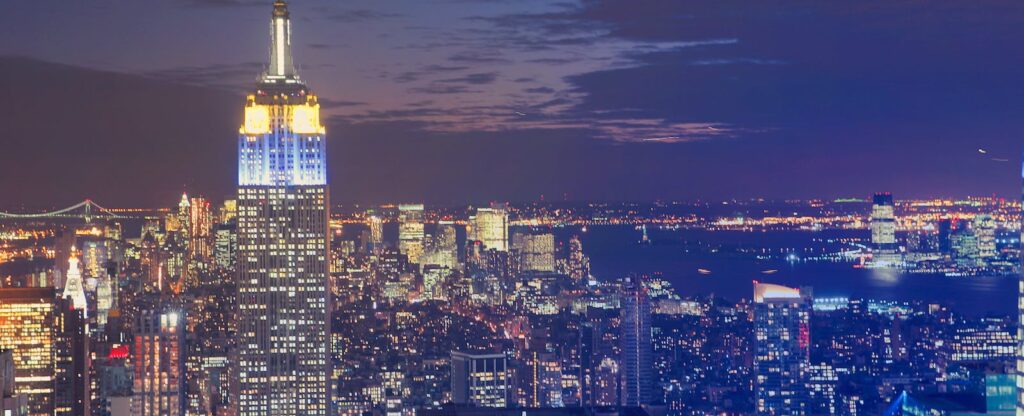The Empire State Building, one of the most recognizable structures in the world, stands proudly in the heart of New York City. Completed in 1931, this Art Deco skyscraper has become a symbol of human achievement, innovation, and architectural prowess. In this blog post, we will delve into the rich history of the Empire State Building and explore the vibrant neighborhoods and attractions that surround it.
The Empire State Building: A Brief History
The Empire State Building, located on the west side of Fifth Avenue between 33rd and 34th streets in Manhattan, was designed by architect William F. Lamb from the architectural firm Shreve, Lamb and Harmon. The construction of the 102-story, 1,454-feet tall building (including its antenna) took just 410 days, with an average of 4.5 stories completed per week. When it opened on May 1, 1931, it held the title of the tallest building in the world, a position it maintained until the completion of the World Trade Center's North Tower in 1970.
The building's name is derived from the nickname for the state of New York, the "Empire State." As an enduring symbol of New York City, the Empire State Building has been featured in countless movies, television shows, and photographs, solidifying its status as an architectural icon.
Exploring the Surrounding Neighborhoods
The Empire State Building is situated in Midtown Manhattan, an area known for its bustling streets, commercial activity, and world-class attractions. The building itself is neighbored by several vibrant districts, including Koreatown, Herald Square, and NoMad. Each of these neighborhoods offers a unique flavor and charm, making a visit to the Empire State Building and its surroundings an unforgettable experience.
Koreatown:
Just a stone's throw away from the Empire State Building, between 31st and 36th streets, lies the bustling neighborhood of Koreatown. Originally established in the 1980s, Koreatown has grown into a thriving cultural hub, offering a plethora of Korean businesses, restaurants, and nightlife options.
Visitors to Koreatown can enjoy authentic Korean cuisine, from traditional dishes like bibimbap and bulgogi to modern fusion fare. For those looking to experience the popular Korean pastime of singing, karaoke establishments abound, with private rooms available for groups large and small.
For a more immersive cultural experience, stop by the Korea Way (32nd Street between Fifth and Sixth avenues), a pedestrian-friendly street lined with Korean bookstores, beauty shops, and cafes. Don't forget to visit the H-Mart, a Korean supermarket offering a wide array of groceries and prepared foods.
Herald Square:
To the southwest of the Empire State Building lies Herald Square, a bustling shopping district named after the now-defunct New York Herald newspaper, which had its headquarters in the area. The intersection of Broadway, Sixth Avenue, and 34th Street forms the square, which is best known for its flagship department store, Macy's Herald Square.
Macy's, the largest retail store in the world, covers an entire city block and spans over 2 million square feet of retail space. This historic store, opened in 1902, is a shopper's paradise, offering everything from clothing and accessories to home goods and electronics.
Herald Square also serves as the endpoint for the annual Macy's Thanksgiving Day Parade, a beloved tradition since 1924. Additionally, the square features a variety of eateries and smaller shops, making it a bustling destination for both locals and tourists.
NoMad:
North of Madison Square Park, the NoMad (North of Madison Square Park) neighborhood has experienced a renaissance in recent years. Once an
industrial area, NoMad has transformed into a trendy destination with a diverse mix of hotels, restaurants, and boutiques. Nestled between the Flatiron District and Midtown, this neighborhood offers a blend of historic charm and contemporary flair.
History buffs will appreciate the stunning architecture of NoMad, with notable landmarks such as the Flatiron Building and the MetLife Tower. For those interested in design and creativity, the Museum of Mathematics and the Museum at the Fashion Institute of Technology are both within walking distance.
NoMad is also home to a thriving culinary scene, boasting a diverse array of eateries ranging from trendy cafes to Michelin-starred restaurants. Among the neighborhood's most acclaimed establishments are the NoMad Hotel's eponymous restaurant, led by chef Daniel Humm, and the innovative Korean-Italian eatery, COTE.
Green Spaces and Outdoor Attractions
Despite its urban setting, the area surrounding the Empire State Building offers several green spaces and outdoor attractions for visitors to explore. Just a short walk south of the building, you'll find Madison Square Park, a 6.2-acre public park that serves as an urban oasis. The park features lush lawns, beautiful gardens, and public art installations, as well as the original Shake Shack location, a must-visit for burger aficionados.
To the north, Bryant Park provides another opportunity for respite from the city's hustle and bustle. Located between Fifth and Sixth avenues and 40th and 42nd streets, Bryant Park offers a variety of seasonal events, such as ice-skating in the winter and outdoor movies in the summer. The park is also home to the New York Public Library's Stephen A. Schwarzman Building, a stunning Beaux-Arts landmark that's worth exploring.
Visiting the Empire State Building
No trip to the Empire State Building would be complete without taking in the breathtaking views from its world-famous observatories. The 86th floor open-air observatory offers panoramic views of New York City, while the enclosed 102nd floor observatory provides an even higher vantage point. For an unforgettable experience, time your visit for sunset to witness the cityscape transform as the day turns to night.
Tickets for the observatories can be purchased online or on-site, with options for express access or guided tours. Inside the building, you'll also find the Empire State Building Experience, an interactive exhibit that delves into the history, construction, and cultural significance of this iconic skyscraper.
Conclusion:
The Empire State Building is not just an architectural marvel; it is a symbol of human ingenuity and a testament to the city's resilience. The building and its surrounding neighborhoods offer an abundance of experiences for visitors to enjoy, from world-class shopping and dining to cultural attractions and green spaces. Whether you're a first-time visitor or a lifelong New Yorker, exploring the Empire State Building and its vibrant surroundings promises to be an unforgettable experience.


